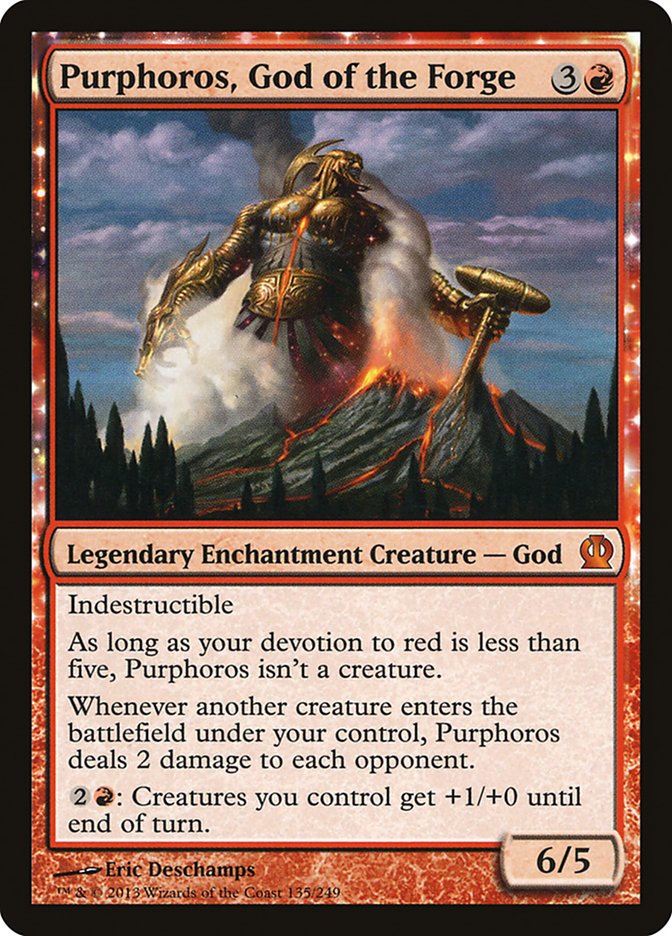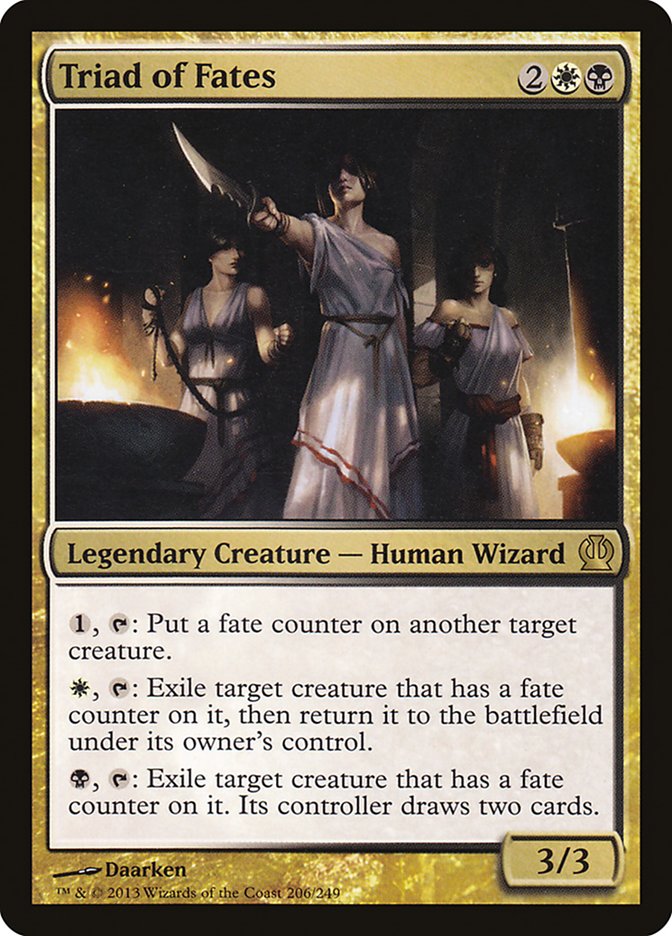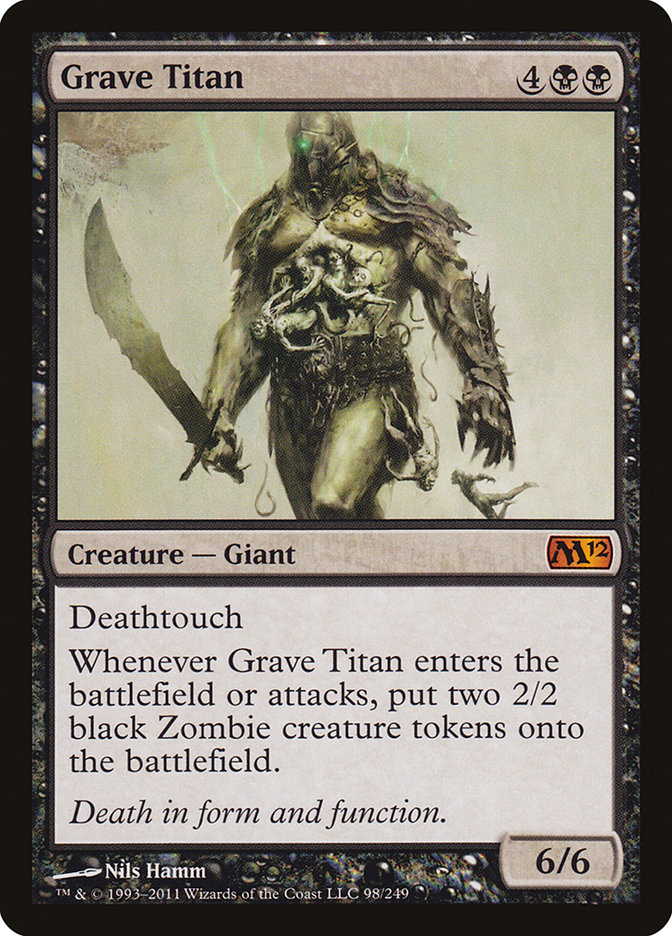Theros looks to be an incredible set full of fun cards to experiment with. I really want to build decks that harness the goods that WotC has given us, so thanks for making these cool cards!
Every time a new set hits the pavement, I just salivate with fresh deck ideas inspired by the basic concepts of the set. And this is a Greek themed set, no doubt.
I was really hoping to build a Commander deck around a legendary dork that inspired me. Lots of people are using the Gods and other legendary creatures as inspirations for decks right now. I wanted something a little different. Many are trying to figure out the ideal Forge[/author]“]Purphoros, God of the [author name="Forge"]Forge[/author] deck or how to break Anthousa, Setessan Hero.
Instead of rolling out a deck designed around a powerful Theros legendary creature like normal, I want to build a flavorful Greek-inspired deck instead. I won’t be adding Commander’s Greatest Hits to a list sporting Anax and Cymede. I want to take a creature and then add in many of the great Greek cards from Magic’s history to sport a different sort of deck.
I decided on Triad of Fates. It is not powerful by any stretch of the imagination and thus strikes me as quite useful in a commander role. Plus I have access to many mythological creatures in both white and black. A Greek-themed deck with blue, for example, might be overly Merfolk-y, while a red deck might have too many Minotaurs. But not so the white and black sections of the color wheel!
Therefore, instead of building an obvious Triad of Fates deck, I wanted to use this as an opportunity to build just a Greek-themed deck. The only nod I’ll make to the card is to add in an Oblivion Stone, which also uses and abuses fate counters. Other than that (and Sol Ring), every nonbasic land card should have some Greek theme to it.
So let’s look at Triad of Fates.
Creatures (35)
- 1 Intrepid Hero
- 1 Lord of the Pit
- 1 Abyssal Horror
- 1 Infernal Medusa
- 1 Hell's Caretaker
- 1 Sanctum Guardian
- 1 Visara the Dreadful
- 1 Deathgazer
- 1 Temple Acolyte
- 1 Mistmoon Griffin
- 1 Screeching Harpy
- 1 Faith Healer
- 1 Capashen Unicorn
- 1 Reborn Hero
- 1 Loyal Sentry
- 1 Viscera Seer
- 1 Grave Titan
- 1 Sun Titan
- 1 Typhoid Rats
- 1 Xathrid Gorgon
- 1 Deathgaze Cockatrice
- 1 Banisher Priest
- 1 Celestial Archon
- 1 Hundred-Handed One
- 1 Heliod, God of the Sun
- 1 Nighthowler
- 1 Erebos, God of the Dead
- 1 Hythonia the Cruel
- 1 Heliod's Emissary
- 1 Keepsake Gorgon
- 1 Opaline Unicorn
- 1 Decorated Griffin
- 1 Erebos's Emissary
- 1 Burnished Hart
- 1 Triad of Fates
Lands (21)
Spells (44)
- 1 Wrath of God
- 15 Plains
- 1 Sol Ring
- 1 Astrolabe
- 1 Underworld Dreams
- 1 The Abyss
- 1 Hellfire
- 1 Oblivion Stone
- 1 Lightning Greaves
- 1 Altar's Light
- 1 Damnation
- 1 Heroes Remembered
- 1 Judge Unworthy
- 1 Armillary Sphere
- 1 Divine Verdict
- 1 Gorgon Flail
- 1 Solemn Offering
- 1 Basilisk Collar
- 1 Seer's Sundial
- 1 Temple Bell
- 1 Divine Deflection
- 1 Underworld Connections
- 1 Dark Prophecy
- 1 Gift of Immortality
- 1 Rescue from the Underworld
- 1 Read the Bones
- 1 Hero's Downfall
- 1 Spear of Heliod
- 1 Whip of Erebos
- 1 Fleetfeather Sandals

As a reminder, this deck is built around the theme of being Greek, not necessarily the best Commander deck ever constructed. I tried to keep the cards good for EDH, but the theme is flavor, not power. Still, I kept back flavorful cards that I just didn’t see as any good, such as Shield Bearer and Hero’s Demise.
Of course, I wrote down the Gods and their weapons first. They are so important to the world and concept that they are must-plays.
Then I began by pulling out a lot of fun cards from Theros for my Fates deck. Cards such as Hundred-Handed One joined useful additions like Nighthowler and Celestial Archon. There’s lots of was to be had from Theros!
I added in both Gorgons from Theros, the potent Hythonia the Cruel and her baby Keepsake Gorgon. Both can kill stuff when they get all monstrous. I liked adding in a Gorgon theme, so in went Visara the Dreadful (who is a powerful card on her own for Commander) as well as Xathrid Gorgon and even Infernal Medusa. We will block and kill stuff on the ground!
I then looked at other mythological creatures to see if I could put any in the deck. After looking up Cockatrice, I rolled Deathgaze Cockatrice in the deck as a great roadblock in the sky. Harpies are also great, and Screeching Harpy joins our good death rooster friend in flying defense. I also like Deathgazer’s impression of a basilisk, so I included it too.
I moved into Greek-inspired white creatures too. Capashen Unicorn is an odd Disenchant effect, but it works. Don’t forget the two Griffins that were deemed useful—Mistmoon Griffin, which will animate something for free when it goes, and the new Decorated Griffin for general defense. Other creatures tended to be too weak to run (like the Pegasus cards I saw)
What are some other useful cards that have a Greek-ish theme? We already saw Sun Titan in one of the Duel Decks, so it and Grave Titan were easy additions. Another useful Greek theme is that of soldiers and heroes. Intrepid Hero is a great choice; it slays monsters with alacrity. Reborn Hero is also an interesting creature.
I also included a group of Priests and Temple enablers. Temples and shrines play key roles in many Greek stories, as do those who work for and with them. So in went cards like Sanctum Guardian, Banisher Priest, Temple Acolyte, and Faith Healer.
Another theme is that of the underworld and creatures from it. At first I threw in Hell’s Caretaker to represent that aspect of mythology. There are also bottomless pits and such, so in went Lord of the Pit, a classic Magic card. Although weak in this deck (and this format), it gives a nice flavor push. Abyssal Horror represents one creature from the Abyss reaching out to hit the world.
Finally, I rounded out my creatures with cards like Viscera Seer, Typhoid Rats, and a few other choices to flesh out my ideas. I knew that I needed land searching and mana making, so I was sure to include both Burnished Hart and Opaline Unicorn.
I considered Sol Ring and Oblivion Stone to be my two nonbasic land cards to count off-theme because of their essential nature in this deck. Then I looked up others. I saw that the Greeks used Armillary Spheres and Astrolabes when I researched them. So they were added to assist with the mana needs of the deck.
Again, I added fun cards from Theros, such as Fleetfeather Sandals, Gift of Immortality, and Read the Bones. Once I had done that, I looked again for flavorful cards that fit the theme of the deck nicely enough. I like mass removal in my Commander decks as a nice reset button. Sure, Hythonia and the Stone can do that, but so can Hellfire, Damnation, and Wrath of God. Each card represents somebody (or something) being angry enough to blast the world—some from Olympus and one from Hades.
Lightning Greaves feels quite Greek to me. Greaves are mentioned often in Greek mythology, so it suited the deck quite nicely. I also like how both Gorgon Flail and Basilisk Collar have interesting synergy with an established mythological monster.
I started looking at other cards. In went The Abyss for creature control. I needed some card draw badly, so in went Underworld Connections, Temple Bell, Dark Prophecy, and Seer’s Sundial. (The Prophecy represents the regular usage of people like oracles and seers to see the future. I know that the Underworld Connections is probably the biggest push to the theme I gave.)
This deck needed removal badly, particularly artifact and enchantment removal. I needed on-theme removal. Again, I mined the concept of worship of the gods by including Solemn Offering and Altar’s Light, as well as divinity for Divine Verdict and Judge Unworthy for creatures. I wish I could have added a few more cards, but I couldn’t see flavor-based reasons to include many cards.
Divine Deflection is a very useful way to prevent damage, kill something, and give my deck a useful trick to rely on when needed. Heroes Remembered ties into the hero theme of Greek/Theros and gives me a bunch of life.
Recalling the myth of the minotaur and the labyrinth, I added both Mystifying Maze and Maze of Ith to the deck. Both are strong cards at keeping folks away from my side of the table.
The few final cards included the Temple/Shrine lands of Godless Shrine, Temple of the False God, and Deserted Temple. Another theme of Greek stories involves places that either worship false gods or which the gods have abandoned; these card concepts tie into those ideas.
And that is my deck. When building a deck with a flavor-based theme such as this one, a lot of interesting questions get raised. How many cards can I add to the deck without hurting the flavor theme? Take Theros for example. There are cards in the set that are not specifically Greek in theme, such as reprints Last Breath and Thoughtseize. Of course, with the right art and flavor text, they have been given some, but the card concepts are hardly resonant in a Greek-themed set like Theros.
With that idea in mind, could a deck like my Triad of Fates concept include a bunch of cards that have neutral flavor? Could I include Vindicate or Mortify for removal? Obviously adding cards like Obzedat’s Aid; Kokusho, the Evening Star; or Commander Eesha would feel out of place. (Perhaps some might object to Visara in the deck for similar reasons.)
How far can a deck like this push the generic cards without watering down the theme overly much? I think it’s up to each deckbuilder to decide; it’s more art than statistics. I don’t want to say that 15% of your nonlands can be off-theme, generic cards with names like Mind Shatter, Swords to Plowshares, Oblivion Ring, Necrologia, and Return to Dust. But what about ones that are a little close, such as Faith’s Fetters? I have Typhoid Rats, Loyal Sentry, and Underworld Connections—all with loose themes at best. Surely Faith’s Fetters would be fine as a one-of.
But for me, I felt it was too much to make my deck that needed to be intentional about being on-theme flavor-wise and then rock cards with neutral concepts like Beacon of Unrest, Decree of Justice, or Profane Command.
Besides, if I started adding in all of these powerful cards with generic concepts in order to round out my deck, pretty soon this deck would look a lot like most other B/W Commander decks. How Theros is a list of cards that has added in all of these greatest hits of Magic? Even if I keep an eye open to exclude anything that is not generic in theme or Greek in substance, I would still have a very different deck. It would rock cards like Mind’s Eye over Seer’s Sundial, Wasteland as an additional land, and Terminus instead of Divine Verdict.
Triad of Fates would not approve of such measures.
Until later,
Abe Sargent









